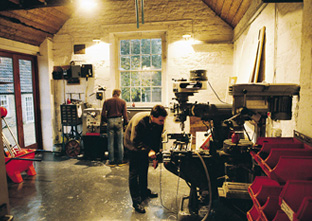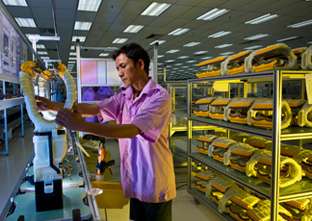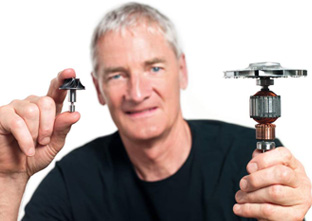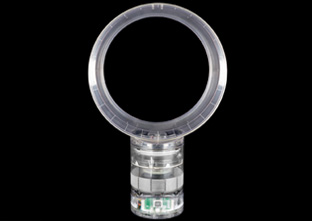"Dyson's design philosophy takes both form and function into account."

Dyson's products combine effectiveness and design. Is there a genuine desire to create beautiful objects, or does technology influence the form ?
Dyson is first and foremost an engineering company. Our main concern is developing and commercialising products that are more effective than those that are already on the market. Our motto remains fairly simple, we constantly question the things that exist and we think about how we could improve them. This process takes avenues that may seem illogical at first, but they do deliver results in the end. Our engineers enjoy solving problems that others have ignored. All this to say that technology comes ahead of design. Our desire to create beautiful objects is in no way essential. We are guided by practicality and not appearance.

Nevertheless, your products are outstandingly designed and you have often received awards for the originality of your designs ?
 That is true, but the word design must be taken in the literal sense. Design is nothing if it does not contribute anything in terms of technology or ergonomics. One of my first products to gain notoriety in the 1970s was the Ballbarrow, literally the "ball-wheelbarrow". The wheelbarrow is both strong and lightweight thanks to the plastic materials used. Better yet, and this is where design comes in, it has a spherical wheel which prevents it from sinking into soft ground. The fact that the wheel has a fairly unconventional design is first and foremost due to its function. That being said, I received the Building Design Innovation award three years after unveiling my invention.
That is true, but the word design must be taken in the literal sense. Design is nothing if it does not contribute anything in terms of technology or ergonomics. One of my first products to gain notoriety in the 1970s was the Ballbarrow, literally the "ball-wheelbarrow". The wheelbarrow is both strong and lightweight thanks to the plastic materials used. Better yet, and this is where design comes in, it has a spherical wheel which prevents it from sinking into soft ground. The fact that the wheel has a fairly unconventional design is first and foremost due to its function. That being said, I received the Building Design Innovation award three years after unveiling my invention.
It seems like a big leap from the wheelbarrow to the vacuum cleaner. What happened ?

In appearance only. You have to understand the Dyson company's philosophy. We are not ones to indulge the mad scientist or oddball inventor mentality. We are only seeking to improve the common objects that surround us, and it is that frame of mind which is our calling card, sort of like a corporate culture that all our employees take on. The idea of reinventing the vacuum cleaner came about in the 1970. While renovating my house, I found that my vacuum cleaner would often get clogged up and lose sucking power. After a short analysis of the problem, I came to the conclusion that the sticking point was the bag. I decided to look at how vacuum cleaners work and how to get rid of the bag. I built over 5,000 prototypes over the course of five years.
In 1983, when I was finally satisfied with the result, I went to various companies with my "Dual Cyclone" concept, an innovative technology that uses the vortex effect to separate dust from air within the vacuum cleaner - the dust is propelled directly into a bin. Called G-Force, my vacuum cleaner had new colours and a distinctive design. In fact, it would appear on the cover of Design Magazine in 1983.
How are Dyson vacuum cleaners revolutionary ?
In addition to their effectiveness, our vacuum cleaners do not use bags and have permanent washable filters. There are no consumables involved, and therefore no extra costs either. We invented this revolutionary generation of vacuum cleaners. When I invented the cyclone technology, the major vacuum cleaner manufacturers were not interested. And they subsequently tried to copy it. And they are still trying to this day. In vain, however, as our technologies are legally protected. This is why our vacuum cleaners are still unique on the market. We have a culture of secrecy and only file for patents when the development process has reached maturity.

Some models of your vacuum cleaners resemble rocket nozzles. Was this purposefully done to give them a futuristic appearance ?
 No, and for the same reasons, we will never design an object with the aim of making it beautiful or fashionable. What you call nozzles are movable parts that oscillate and vibrate in order to prevent the dust from clogging the system. There are 54 in total. However, we have to admit that they contribute to our vacuum cleaners' unique appearance. In fact, we have a single goal: to achieve an unmatched level of performance while making our machines as comfortable to use as possible. All parts of the vacuum cleaners, for instance, contribute to achieving this objective. The principle is based on fluid mechanics which must enable the air to suck in all kinds of particles while avoiding excessive turbulence in order to reduce noise and vibrations.
No, and for the same reasons, we will never design an object with the aim of making it beautiful or fashionable. What you call nozzles are movable parts that oscillate and vibrate in order to prevent the dust from clogging the system. There are 54 in total. However, we have to admit that they contribute to our vacuum cleaners' unique appearance. In fact, we have a single goal: to achieve an unmatched level of performance while making our machines as comfortable to use as possible. All parts of the vacuum cleaners, for instance, contribute to achieving this objective. The principle is based on fluid mechanics which must enable the air to suck in all kinds of particles while avoiding excessive turbulence in order to reduce noise and vibrations.
Does the fact that your vacuum cleaners have so many transparent parts come from a desire to "sublimate" your technology ?
 You could say that, and it is also because we are proud of our technology. We believe that users should understand how their machines work, so we use as much transparent plastic as possible. For the other parts, we use a lot of ABS polycarbonate, the same material used to manufacture riot shields and motorcycle helmets. This material is essential because it is lightweight and very shock-resistant. We could have used a different polymer, like many of our competitors have, but our products' quality would certainly not have been the same.
You could say that, and it is also because we are proud of our technology. We believe that users should understand how their machines work, so we use as much transparent plastic as possible. For the other parts, we use a lot of ABS polycarbonate, the same material used to manufacture riot shields and motorcycle helmets. This material is essential because it is lightweight and very shock-resistant. We could have used a different polymer, like many of our competitors have, but our products' quality would certainly not have been the same.
Speaking of which: How do you choose your polymers ?
Each component is relentlessly tested. We subject them to over 50,000 hours of testing in order to ensure that they are able to withstand intensive use over the whole of their lifespan. As an example, the cable's winding mechanism is wound and unwound 6,400 times. These are crucial tests, but they are not the only ones because we are constantly on the lookout for new polymers that can enable us to manufacture ever finer and lighter parts that do not compromise performance. As a result, we have managed to develop a particularly compact vacuum cleaner which is therefore lighter and easier to store. It goes without saying that its technical specifications are equivalent to the larger models.

We could also mention some of our brushes which also provide better handling as they are lightweight and fully articulated. The bristles are made from carbon fibre, a material which is rigid enough to dislodge dust from the grooves in parquet flooring, or they can also be wrapped in nylon and used to remove deep-lying dust in carpets and rugs.
What types of polymers do you use ?

The answer is highly confidential as it is of strategic importance for our company. I will simply say that we are actively participating in research on new polymers. The engineers are continually refining and rethinking their inventions. As a result, the latest lines of our products work just as well as the previous generations while requiring fewer materials, fewer components and smaller motors. The latter actually perfectly illustrate our know-how, and they could not have been developed without the addition of new polymers, particularly those that use the BallTM Technology. The motor is inserted into a ball that works as a wheel. This may seem trivial, but you cannot imagine the treasures of technology that are to be found in this design. It is not a gadget, as users benefit from incomparable comfort of use.
This generation of vacuum cleaners turns on the spot for better manoeuvrability. The chassis and the cyclone system are articulated, which enables users to easily get around obstacles throughout the house.
Dyson is best known for its vacuum cleaners. However, you are currently developing other lines of products. Can you tell us any more ?
 We sell several categories of products: fans, heaters, hand dryers and hand-dryer faucets. For the time being, our products are focused on a single element: air. However, it is likely that Dyson may launch other categories of products outside of that specific spectrum. As a matter of fact, from 2015, we are preparing to launch a new category of product every year. However, Dyson cannot comment on its future launches. But we will be telling you all about them very soon!
We sell several categories of products: fans, heaters, hand dryers and hand-dryer faucets. For the time being, our products are focused on a single element: air. However, it is likely that Dyson may launch other categories of products outside of that specific spectrum. As a matter of fact, from 2015, we are preparing to launch a new category of product every year. However, Dyson cannot comment on its future launches. But we will be telling you all about them very soon!
Will the same philosophy be used for these products ?
We attach the same level of importance to all our products. As an example, the bladeless fan was improved upon in the spring. We reduced the noise it makes and its energy consumption. We are constantly trying to improve our products, it is in our DNA and, as you can probably imagine, improvements also require the development of new polymers.






